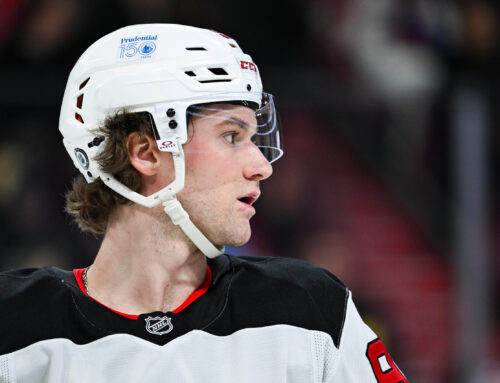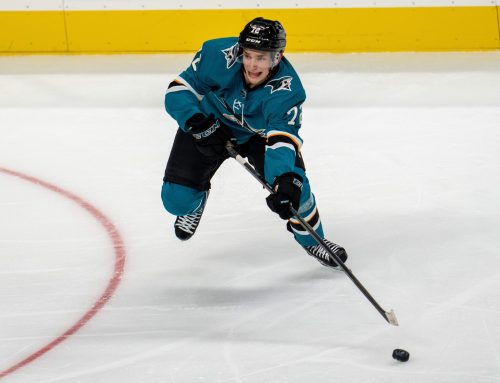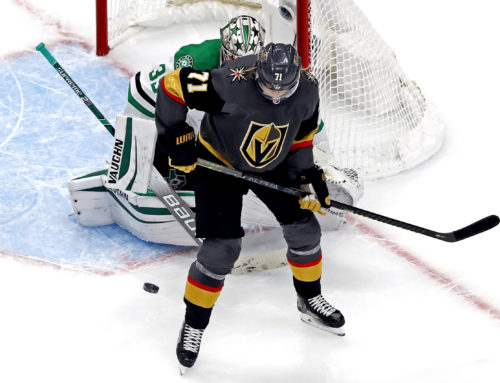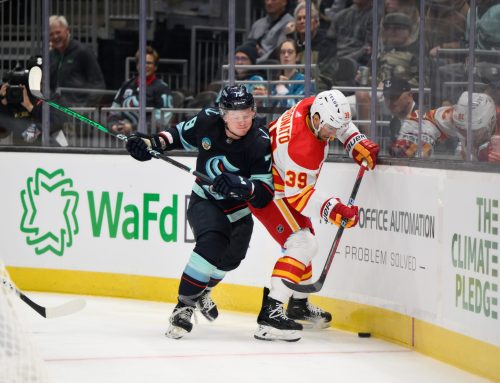
New year, new lines. In this week’s instalment, I’ll let you know which lines to watch out for in the new year. Before we get into that, we’ll take a quick glance at each team’s most productive line during the 2018 portion of this season. Using Dobber’s Line Production Tool, I compared even-strength point production from around the league. ‘Time on ice’ represents how many minutes each trio has played as a line this season, values were retrieved from Natural Stat Trick.
|
# |
Team |
Line |
Points |
Time on Ice |
|
1 |
Colorado |
88 |
573:27 |
|
|
2 |
Columbus |
61 |
389:13 |
|
|
3 |
Calgary |
58 |
443:45 |
|
|
4 |
Montreal |
54 |
393:49 |
|
|
5 |
Toronto |
53 |
386:37 |
|
|
6 |
Dallas |
45 |
291:46 |
|
|
7 |
Tampa Bay |
45 |
223:58 |
|
|
8 |
Winnipeg |
43 |
349:55 |
|
|
9 |
New Jersey |
40 |
295:18 |
|
|
10 |
Buffalo |
38 |
279:21 |
|
|
11 |
Philadelphia |
37 |
240:04 |
|
|
12 |
San Jose |
34 |
231:25 |
|
|
13 |
Carolina |
32 |
254:04 |
|
|
14 |
Los Angeles |
32 |
393:58 |
|
|
15 |
Vegas |
31 |
496:36 |
|
|
16 |
Minnesota |
30 |
293:07 |
|
|
17 |
Boston |
29 |
232:13 |
|
|
18 |
Ottawa |
Brady Tkachuk – Colin White – Mark Stone |
28 |
231:25 |
|
19 |
Nashville |
26
📢 advertisement:
|
147:34 |
|
|
20 |
Pittsburgh |
26 |
147:58 |
|
|
21 |
Islanders |
25 |
233:19 |
|
|
22 |
Edmonton |
21 |
161:49 |
|
|
23 |
Florida |
19 |
201:25 |
|
|
24 |
Washington |
19 |
105:30 |
|
|
25 |
Chicago |
18 |
178:54 |
|
|
26 |
Detroit |
17 |
150:28 |
|
|
27 |
Vancouver |
16 |
88:22 |
|
|
28 |
Rangers |
16 |
74:37 |
|
|
29 |
Anaheim |
Max Comtois – Adam Henrique – Jakob Silfverberg |
12 |
51:52 |
|
30 |
Arizona |
9 |
44:00 |
|
|
31 |
St. Louis |
Zach Sanford – Ryan O'Reilly – David Perron |
9 |
65:46 |
Dissecting the Data
As you might imagine, lines that have more time on ice together tend to produce more. So, it makes sense that teams at the bottom of this list have suffered notable injuries (suspensions in the case of Tom Wilson and Washington), or have struggled often enough to warrant constant line juggling.
This makes production from the Johnson-Point-Kucherov line so much more impressive because they’ve taken considerably less time to put up so many points. In contrast, production from Vegas’ top line of Marchessault-Karlsson-Smith has been disappointing considering they’ve seen so many minutes together.
Although I am surprised that the Galchenyuk-Schmaltz-Keller line hasn’t produced more than nine even-strength points at this point, I’m sure they’ll take over the team lead soon.
One line I did not expect to see near the top of this list was Montreal’s trio of Tatar-Danault-Gallagher. It’s one of the few lines on this list without any ‘star’ power, but they seem to outwork their opponents every night.
New Year’s Rising Solutions
Filip Forsberg – Ryan Johansen – Viktor Arvidsson
With both Forsberg and Arvidsson sidelined with injuries for lengthy periods this season, this trio has been together for just 13 of Nashville’s 40 games. With Arvidsson healthy again and Forsberg’s return scheduled for some time in January, 2019 will give this line an opportunity to show us why they’re one of the best in the league. I shared some of their advanced stats in last week’s column, but I’ll remind you that they’ve controlled 58% of shot attempts, 59% of scoring chances and 68% of high-danger scoring chances while on the ice. Last season they outscored their opponents 38-17, expect more of the same in the new year.
Rickard Rakell – Ryan Getzlaf – Ondrej Kase
If you’ve been reading these articles on a weekly basis, you’re probably familiar with my love for the Ducks and their amazing off-day schedule. Since Anaheim plays more than 60% of their games on Monday/Wednesday/Friday/Sunday this season it’s easy to incorporate guys like Getzlaf, Rakell, and Kase into your lineup. Speaking of Rakell, he’s currently scoring on just under six percent of his shots – an extremely low number considering how efficient a shooter he’s been in his career. He’s also close to returning from an ankle injury, so his value can only increase in the new year. While I’d like to see Kase on this line, Pontus Aberg might be a more likely candidate.
Jamie Benn – Tyler Seguin – Alex Radulov
By now, I’m sure you’re familiar with what Stars’ CEO Jim Lites had to say about Benn and Seguin’s play this season – calling them freaking horse poop (I should probably ask Dobber what our policy for profanity is). However, I’m not going to sit here and tell you that those comments are going to spark Benn and Seguin, inspiring them to produce more in 2019. What I am going to tell you is that Jamie Benn is on pace for just 63 points. In the past five seasons, his worst pace put him on track for 73 points (in 2016-2017 when he finished the year with 69 points in 77 games). At 29 years of age, Benn is still very much capable of putting up 70-80 points in a season, and I think his production will improve as Seguin’s luck improves. Seguin leads the league with 11 shots off the post/crossbar and his shooting percentage of 7.5% is lower than his career average. Dallas’ offense wasn’t at full-strength for the majority of this season’s first half, as both John Klingberg and Alex Radulov were dealing with significant injuries. Now that all the team’s offensive stars are healthy, I think the Stars will score more in 2019.
Jaden Schwartz – Brayden Schenn – Vladimir Tarasenko
Averaging just 2.81 goals for per game, the St. Louis Blues are in the bottom third of the league when it comes to offensive production. The fact that they’re struggling to score goals is made even more surprising when you consider that Ryan O’Reilly has 34 points in 36 games. The reality is, their best line from last season which featured Schwartz, Schenn, and Tarasenko, has struggled mightily this season. Tarasenko has just 22 points in 36 games, Schenn has 22 points in 32 games, and Schwartz has 14 points in 23 games. This is a line that dominated their opponents in possession last season. They controlled 60% of shots, 63% of scoring chances and 61% of high danger scoring chances while on the ice. While they might not be as dominant in terms of possession this season, they are still generating more shots and scoring chances than their opponents. In fact, their controlling an even larger share (67%) of high-danger opportunities in 2018-2019! Despite out-chancing their opponents, they’ve been outscored 8-4. This is partially explained by their on-ice shooting percentage which sits at a measly 5.1% – a number that was all the way up at 9.7% last season.
Andreas Johnsson – Auston Matthews – William Nylander
William Nylander has 2 points in 11 games this season. I think that’s a long enough adjustment period after he missed the beginning of the season amidst a lengthy contract negotiation. It wasn’t realistic to expect much of Nylander as soon as he returned to the lineup, considering he hadn’t played with his teammates in months. But now that he’s had a few games to readjust to the pace of the NHL, I expect him to start producing. Nylander is an extremely talented player who posted 60 points in each of his two full seasons. He has great chemistry with Auston Matthews – who has shown glimpses of being one of the league’s most talented forwards. Ideally, a hard-working forechecker like Zach Hyman would complete this line, but Hyman has been extremely successful with John Tavares and Mitch Marner and is currently injured. While I think Nylander and Matthews will be extremely successful in 2019 regardless of whom they’re playing with, it looks like Andreas Johnsson is currently the third member of this line.





 CHI
CHI BUF
BUF NYR
NYR TOR
TOR EDM
EDM PIT
PIT N.J
N.J L.A
L.A DET
DET CAR
CAR CGY
CGY
